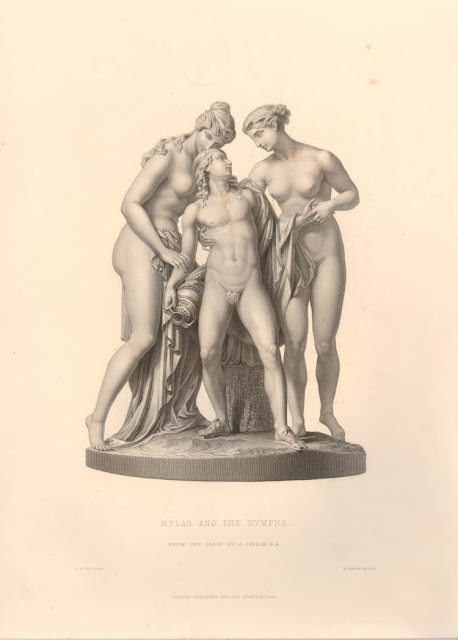 |
| Roman mosaic Hylas and the Nymphs 2nd century BC Palazzo Massimo alle Terme, Rome |
 |
| Roman mosaic Hylas and the Nymphs AD 200-300- Musée Gallo-Romain de Saint-Romain-en-Gal, Vienne, France |
 |
| Roman mosaic Hylas and the Nymphs AD 300-350 Palazzo Massimo alle Terme. Rome |
 |
| copy of a drawing by Giulio Romano Hylas and the Nymphs 16th century drawing Royal Collection, Great Britain |
 |
| Pietro Santi Bartoli after Giulio Romano Capture of Hylas by the Nymphs ca. 1655-1700 etching British Museum |
HYLAS AND THE WATER NYMPHS
And straight he was aware
Of water in a hollow place, low down,
Where the thick sward shone with blue celandine,
And bright green maiden-hair, still dry in dew,
And parsley rich. And at that hour it chanced
The nymphs unseen were dancing in the fount –
The sleepless nymphs, reverenced of housing men,
Winning Eunica; Malis, apple-cheeked;
And, like a night-bedewed rose, Nichea.
Down stepped the boy, in haste to give his urn
Its fill, and pushed it in the fount; when, lo!
Fair hands were on him – fair, and very fast;
For all the gentle souls that haunted there
Were drawn in love's sweet yearning tow'rds the boy;
And so he dropped within the darksome well –
Dropped like a star, that, on a summer eve,
Slides in ethereal beauty to the sea.
– from an Idyll of Theocritus, translated by Leigh Hunt (1844)
 |
| Francesco Furini Hylas and the Nymphs 1630 oil on canvas Palazzo Pitti, Florence |
 |
| Baldassare Franceschini Hylas with water-vessel before 1689 oil on canvas Staatsgalerie Stuttgart |
 |
| Solomon Gessner Hylas and the Nymphs 1771 etching National Gallery of Art, Washington DC |
 |
| Anonymous French painter Hylas and Nymph 19th century oil on canvas private collection |
 |
| John Gibson Hylas surprised by the Naiades 1827-36 marble Tate Britain |
"This life-size statue group in white marble presents a scene from Greek mythology in which the boy Hylas, the companion of Hercules, goes to collect water from a stream, and is lured into the depths by water nymphs who are entranced by his beauty. The nymphs (Naiades) simultaneously gaze admiringly and move to physically detain the boy. . . . "
"Gibson began his career as a cabinet-maker in Liverpool before moving to London in 1817. Following the advice of John Flaxman, London's leading neoclassical sculptor, he traveled to Rome, arriving in October of that year. Having received training from the Italian master Antonio Canova and the Danish sculptor Bertel Thorvaldsen (who also made a relief of this subject), Gibson produced works based on the close study of Greek and Roman antiquity. He was commissioned to produce this work in May 1826 but it took many years to complete. The delay was caused by Gibson's patron, the statesman William Haldimand, who decided to withdraw his interest. In 1832 the Liverpool Echo reported to its readers that the work was almost complete. It was finally exhibited at the Royal Academy in 1837, and was given to the nation as part of the Vernon Gift in 1847."
– curator's notes from Tate Britain
 |
| William Callio Roffe after John Gibson Hylas and the Nymphs (John Gibson's marble sculpture) 1854 stipple-engraving British Museum |
| Bertel Thorvaldsen Hylas and the Nymphs before 1844 marble relief Thorvaldsen Museum, Copenhagen |
 |
| John Sartain after Henry Howard Hylas and the Nymphs before 1897 engraving New York Public Library |
 |
| Henry Alfred Pegram Hylas and Water Nymph (statue for fountain) 1922 bronze Regent's Park, London |
 |
| Adolfo De Carolis Hylas and the Nymphs 1916 chiaroscuro woodcut National Gallery of Art, Washington DC |